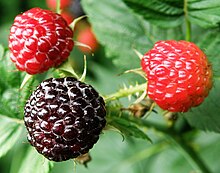Rubus occidentalis
| Rubus occidentalis | |
|---|---|
 |
|
| Scientific classification | |
| Kingdom: | Plantae |
| (unranked): | Angiosperms |
| (unranked): | Eudicots |
| (unranked): | Rosids |
| Order: | Rosales |
| Family: | Rosaceae |
| Genus: | Rubus |
| Subgenus: | Idaeobatus |
| Species: | R. occidentalis |
| Binomial name | |
|
Rubus occidentalis L. 1753 |
|
| Synonyms | |
|
|
Rubus occidentalis is a species of Rubus native to eastern North America. Its common name black raspberry is shared with the closely related western American species Rubus leucodermis. Other names occasionally used include wild black raspberry, black caps, black cap raspberry, thimbleberry, and scotch cap.
Rubus occidentalis is a deciduous shrub growing to 2–3 m (7–10 feet) tall, with prickly shoots. The leaves are pinnate, with five leaflets on leaves, strong-growing stems in their first year, and three leaflets on leaves on flowering branchlets. The flowers are distinct in having long, slender sepals 6–8 mm long, more than twice as long as the petals. The round-shaped fruit is a 12–15 mm diameter aggregation of drupelets; it is edible, and has a high content of anthocyanins and ellagic acid.
Black raspberries are high in anthocyanins. This has led to their being very useful as natural dyes. Preliminary studies to evaluate their benefit for cancer treatment in mammalian test systems are ongoing and a small-scale clinical trial has begun on patients with Barrett's esophagus.
The black raspberry is also closely related to the red raspberries Rubus idaeus and Rubus strigosus, sharing the distinctively white underside of the leaves and fruit that readily detaches from the carpel, but differing in the ripe fruit being black, and in the stems being more prickly. The black fruit makes them look like blackberries, though this is only superficial, with the taste being unique and not like either the red raspberry or the blackberry.
...
Wikipedia
